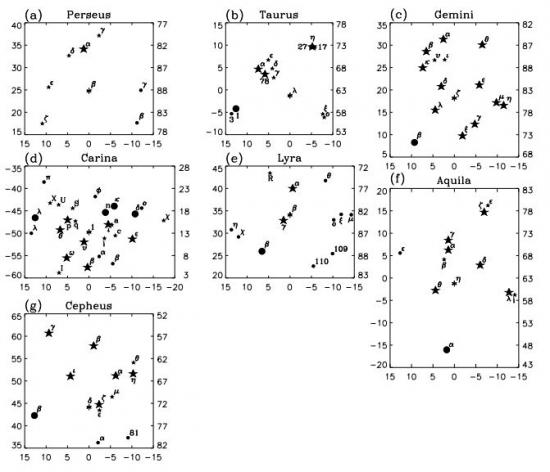Astronomers discovered ancient Egyptian observations of a variable star
University of Helsinki
Source - http://phys.org/news/2012-05-astronomers-ancient-egyptian-variable-star.html
The study of the "Demon star", Algol, made by a research group of the University of Helsinki, Finland, has received both scientific and public attention. The period of the brightness variation of this eclipsing binary star has been connected to good prognoses three millennia ago. This result has raised a lot of discussion and the news has spread widely in the Internet.
The Egyptian papyrus Cairo 86637 calendar is probably the oldest preserved historical document of bare eye observations of a variable star. Each day of one Egyptian year was divided into three parts in this calendar. A good or a bad prognosis was assigned for these parts of a day.
-The texts regarding the prognoses are connected to mythological and astronomical events, says Master of Science Sebastian Porceddu.
A modern period analysis revealed that two statistically significant periods of 29.6 and 2.850 days have been recorded into the good prognoses. The former is clearly the period of the Moon. The second period differs slightly from the period Algol. In this eclipsing binary, the dimmer star partially covers the brighter star with a period of 2.867 days.
-These eclipses last about ten hours and they can be easily observed with bare eyes. Their period was discovered by Goodricke in the year 1783, says docent Lauri Jetsu.
-We can explain why the period of Algol has increased by about 0.017 days, says Lauri Jetsu. The period increase during the past three millennia could have been caused by the observed mass transfer between the two members of this binary. In fact, this would be the first observation that confirms the period increase of Algol and it also gives an estimate of the mass transfer rate.
The ancient Egyptians have made accurate measurements that provide useful constraints for modern astronomers.
-It seems that the first observation of a variable star was made 3000 years earlier than was previously thought, says Lauri Jetsu. However, I want to emphasize that our research has only been sent to a scientific journal about two weeks ago. This type of results can raise a lot of controversy before they are accepted.
The research was made in collaboration by the researchers from the Department of Physics and the Department of World Cultures of the University of Helsinki. It has been published electronically in the arXiv on April 30th, 2012. The Egyptology part of the research will be published separately.

Fig. 7. Star maps close to the seven best variable star candidates. The stars (*and ⋆) in the same modern constellation with the variables (∗) are shown in panels: (a) Algol, (b) λ Tau, (c) ζ Gem, (d) l Car, (e) β Lyr, (f) η Aql and (g) δ Cep. Only those stars in the same modern constellation are shown which fulfill d ≤ 20
in Table 11. In addition, the stars (. and •) not belonging to the same modern constellation are also shown, if they fulfill d ≤ 15 in Table 11. The right ascension (x-axis:[ o]), declination (left handy-axis:[o ]) and the altitude of upper culmination amax (right hand y-axis:[ o ]) have been calculated for the epoch 1224 B.C., i.e. all units are degrees of arc [da].
More information: Did the ancient egyptians record the period of the eclipsing binary Algol - the Raging one? L. Jetsu, S. Porceddu, J. Lyytinen, P. Kajatkari, J. Lehtinen, T. Markkanen, J. Toivari-Viitala, http://arxiv.org/abs/1204.6206